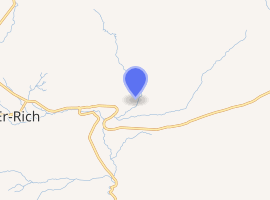Tazmamart
Tazmamart (Arabic: سجن تازمامرت) was a secret prison in south-eastern Morocco in the Atlas Mountains, holding political prisoners. The prison became a symbol of oppression in the political history of contemporary Morocco. It is located near the city of Er-Rich, between Errachida and Midelt. It was managed by commandant Feddoul and Hamidou Laanigri, both Royal Moroccan Gendarmerie officials.[1]
.png) | |

| |
| Location | Tazmamart, near Rich |
|---|---|
| Coordinates | |
| Status | Closed and destroyed. |
| Opened | late 1970s |
| Managed by | Commandant Feddoul Hamidou Laanigri[1] |
| Country | Morocco |
| Notable prisoners | |
| Ahmed Marzouki Ali Bourequat | |
History
Tazmamart Prison was built in 1972,[2] after the second failed coup d'etat against the late Hassan II of Morocco in August 1972, 58 army officers were sent to Kenitra prison and later to Tazmamart. According to Ali Bourequat, the prison later held also some Sahrawi nationalists and other "disappeared" political offenders.
During the 1980s, there were allegations about the existence of a prison called Tazmamart. Authorities (or Makhzen) were denying all of those allegations. It was not until the publication of the book Notre ami le Roi (Our friend the King) by French journalist Gilles Perrault in 1990 that the issue was raised at a political level. Thomas Miller, who at the time was Director for North African Affairs at the State Department, said in an oral history that he was contacted by American citizen Nancy Touil, who said her husband M’Barek Touil had been languishing in Tazmamart for nearly two decades. Miller inserted a talking point in the background papers for President George H.W. Bush for his 1991 meeting with King Hassan. Bush raised the issue, much to the King's dismay.[3]
In 1991, and after pressure from international human rights groups and some foreign governments, Hassan II of Morocco decided to close down the prison and release the last remaining detainees. Some fled abroad, others stayed in Morocco, but were prevented from discussing their experiences in Tazmamart publicly.[4]
Human conditions
According to some former detainees and human rights groups, conditions at Tazmamart were extremely harsh. While torture and ill treatment occurred, the appalling prison conditions were the biggest threat to the lives of inmates.
The prisoners were put in cramped single-person underground cells 24 hours a day. They were allowed no human contact, no light, and very little in the way of food or protection from the summer heat, or winter cold. There was no medical treatment for injuries caused by torture and diseases like tuberculosis. Also, the food rations were minimal.[5] There are also allegations of executions.[6] All in all, 35 prisoners, or more than half of the people incarcerated at Tazmamart during the eighteen years died,[7] before the prison was finally closed in 1991.
Post-Years of lead
Rumours about Tazmamart's existence were put about as an instrument of terror by the makhzen, but even though several human rights organizations had reported on existence of Tazmamart,[8] the regime officially denied all knowledge of the prison until 1991 [9] when US pressure forced the release of the surviving prisoners. The camp was closed along with several others of its kind, but Tazmamart remains a particularly powerful symbol of the oppressive "years of lead" in Morocco. Survivors have staged memorial marches to the prison.[10]
Rumours persist about the continued existence of Tazmamart-style camps in Morocco, as it has been documented that secret detention and torture of suspects continues, possibly in collaboration with the American CIA (see Black sites).[11][12]
Publications by former inmates
Several of the former inmates have since written books on their sometimes decades-long stay in Tazmamart, for example Ali Bourequat's In the Moroccan King's Secret Gardens and Ahmed Marzouki's Tazmamart: Cell No. 10. Famous Moroccan writer Tahar Ben Jelloun has written This Blinding Absence of Light, based on the experiences of one Tazmamart prisoner.[13]
References
- Mahjoub Tobji (2006-09-13). Les officiers de Sa Majesté:Les dérives des généraux marocains 1956-2006. Fayard. ISBN 978-2-213-64072-3.
- Maghraoui, Abdelslam (Spring 2001). "Political Authority in Crisis: Mohamed VI's Morocco". Middle East Report. 31. Retrieved 7 October 2011.
- Miller, Thomas. "The Power of a Talking Point". ADST.org.
- "U.S. Department of State Morocco Country Report on Human Rights Practices for 1997". US Department of State. Retrieved 7 October 2011.
- Amrawi, Ahmad (21 April 2005). "Morocco reconciles with past state abuses". Al Jazeera. Archived from the original on April 23, 2005. Retrieved 7 October 2011.
- Summerfield, Derek (23 April 1994). "Tazmamart: Fort-Militaire-Secret du Maroc. Consequences d'un Internement du 18 Annees". British Medical Journal. Retrieved 7 October 2011.
- "Human Rights Watch World Report 2002: Middle East & North Africa: Morocco". Human Rights Watch. Retrieved 7 October 2011.
- "MOROCCO Human Rights Developments". Human Rights Watch. 1990. Retrieved 7 October 2011.
- "Morocco: The "disappeared" reappear". Amnesty International. 17 August 1993. Retrieved 7 October 2011.
- "Ex-prisoners demand Morocco trials". BBC. 8 October 2000. Retrieved 7 October 2011.
- "Annual Report: Morocco/Western Sahara 2011". Amnesty International. 28 May 2011. Retrieved 7 October 2011.
- Rose, Rose (11 December 2005). "David". The Observer. Retrieved 7 October 2011.
- Smallman, Lawrence (20 June 2004). "Moroccan writer wins top prize". Al Jazeera. Archived from the original on January 13, 2005. Retrieved 7 October 2011.
Further reading
- Ali Bourequat (1998), In the Moroccan King's Secret Gardens, Maurice Publishers
- Ahmed Marzouki (2000), Tazmamart Cellule 10 (Tazmamart Cell 10), Editions Paris Méditerranée; Casablanca: Tarik Editions (ISBN 2-07-041991-6)
- Tahar Ben Jelloun (2001), Cette aveuglante absence de lumière (That Blinding Absence of Light), Editions du Seuil and New Press, (ISBN 1-56584-723-7) -
- Christine Daure-Serfaty (2002), Tazmamart, (ISBN 2-234-02472-2)
External links
- Amnesty International Statement on the detention of Ali Bourequat and his two brothers
- Royal Gulag, article from The Economist